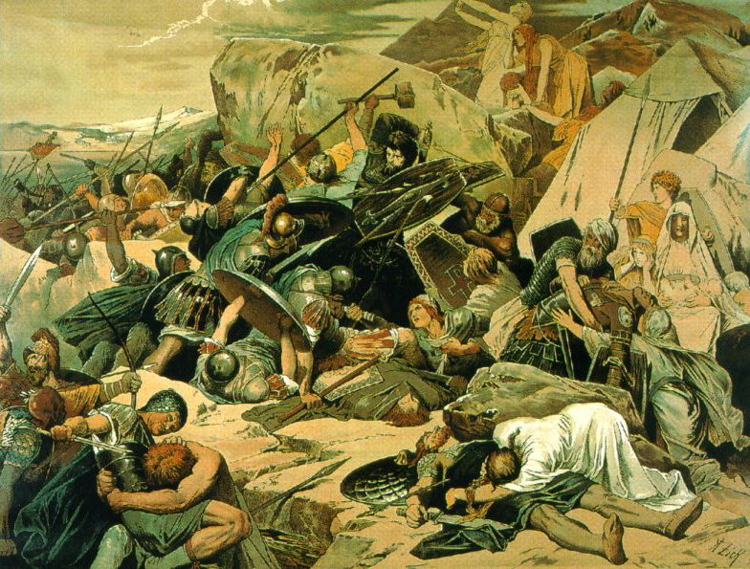
Sicily
Sicily has been owned by practically everybody. The Romans took it from the Greeks. In 440 C.E. the Vandals under King Geiseric seized it, but starting in
488 the Ostrogoths under Theodoric the Great began their conquest of the whole of Italy, including Sicily. In the next century, the Byzantine Empire fought
the Gothic War to recapture Italy. They took Sicily first and made it their base. King Totila of the Ostrogoths fought back down the Italian peninsula and
sacked Sicily in 550, but was defeated and killed in 552. Ravenna, the Ostrogothic capital, eventually fell to the Lombards, whereupon Sicily and the city
of Syracuse became Byzantium's main western outpost.
In 826, Euphemius, commander of the Byzantine fleet at Sicily forced a nun to marry him. Emperor Michael II ordered General Constantine to end the marriage
and cut off Euphemius' nose. Euphemius killed Constantine and occupied Syracuse; when he was defeated and driven into exile in North Africa, he offered the
Emir of Tunisia rule over Sicily in return for sanctuary and a position as a general. An Islamic army was sent but it took over 100 years, until 965, for the
conquest of the island to be completed. Sicily became an emirate.
The downfall of the Emirate of Sicily was internecine conflicts among the Moslem rulers - and the activities of varying groups of Norsemen. During his time
in the Varangian Guard in the first half of the eleventh century, some of Harald Hardrada's triumphs were in Sicily. Meanwhile, mainland South Italian powers
were hiring Norman mercenaries. In 1038, he led the Varangians against the Arabs alongside Normans under William de Hauteville (who won the nickname "Iron Arm"
by defeating the emir of Syracuse in single combat), and Lombards from Byzantine-held Apulia, but the alliance fell apart after the Byzantine general
humiliated the Lombards. In 1041, detachments of Varangians were twice defeated by Normans.
The Normans Robert and Roger Guiscard - brothers of William de Hauteville - had already conquered Calabria when they set their sights on Sicily. They
captured Messina in 1061. After they took Palermo in 1072, Robert invested his brother with the title of Count Roger I of Sicily, although Roger was not
actually in full control until 1091, but he then added Malta. In 1130 his son Roger II made the territory - Sicily, Malta, and southern Italy - into a kingdom.
The Norman rulers encouraged immigration from northern Italy and the island became Catholic and evolved its own peculiar dialect of Italian. In 1194 the crown
passed to Henry VI of Hohenstaufen, a Swabian, by marriage. His son Frederick II, born just as his father was being crowned, was crowned Holy Roman Emperor in
1220 and also became King of Italy and Burgundy and eventually King of Jerusalem as well after participating in the Sixth (Last) Crusade partly to claim the
crown to which he was entitled through his wife. He was deeply learned, created one of the first universities in Europe (at Naples), and was referred to as
stupor mundi, "wonder of the world." He is one of the great characters of the Middle Ages.
The Norman kingdom of Sicily is the last and least known Viking conquest.

Art work by Alexander Zick, Wikimedia Commons
Teia, last King of the Ostrogoths, beating on Byzantine soldiers in front of Mount Vesuvius
[1. Teia, last King of the Ostrogoths image from http://en.wikipedia.org/wiki/File:Mons_Lactarius.jpg]
|
